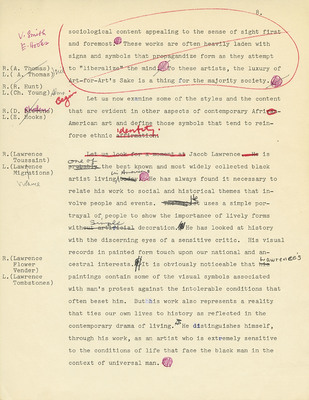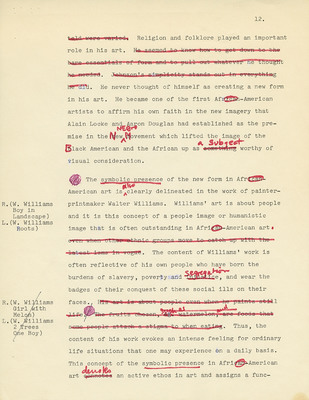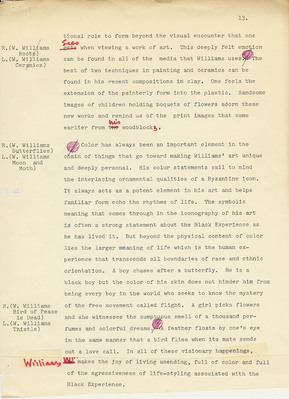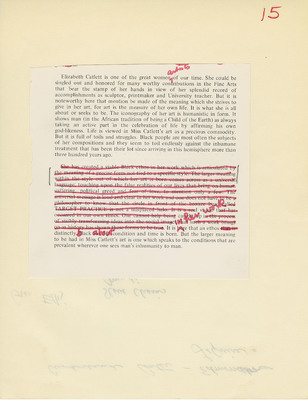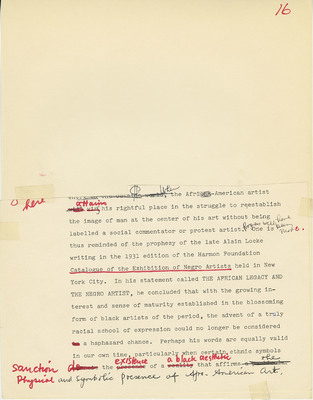Pages That Need Review
MS01.01.03 - Box 01 - Folder 13 - Artist Biographies, [undated]
MS01.01.03.B01.F13.009
8.
Let us now examine some of the styles and the content that are evident in other aspects of contemporary African-American art and define those symbols that tend to reinforce ethnic identity. Jacob Lawrence is one of the best known and most widely collected black artist living in America. He has always found it necessary to relate his work to social and historical themes that involve people and events. He uses a simple portrayal of people to show the importance of lively forms with simple decoration. He has looked at history with the discerning eyes of a sensitive critic. His visual records in painted form touch upon our national and ancestral interests. It is obviously noticeable that Lawrence's paintings contain some of the visual symbols associated with man's protest against the intolerable conditions that often beset him. But his work also represents a reality that ties our own lives to history as reflected in the contemporary drama of living. He distinguishes himself, through his work, as an artist who is extremely sensitive to the conditions of life that face the black man in the context of universal man.
MS01.01.03.B01.F13.011
The life force and the expression of dignity which come through in White's work go beyond the mastery of a technical skill. They advance our knowledge of African-American forms as defined by a sensitive artist in the Black Experience.
In HARVEST, a close kinship with the Mexican muralists is revealed but a the same time the artist relies upon his experiences of life and upon those values that are vital to him and to the people that he knows. This work communicates a felling of wholeness as it speaks symbolically of reaping good deeds through the long harvest.
The late Palmer Hayden, one of the true folklorists of Black Experience, provied us with many themes that dealt with such stories as John Henry, Tricky Sam and many other tales that are dear to the hearts of all Americans.
William H. Johnson saw a colorful lyrical world, as he made his way from the Deep South, across Europe and North Africa into the clear mountain air of Norway above the Artic Circle. Of this twenty year odyssey, he observed life and customs through the univerrsal language of art. We see two aspects of his life here - Europe and the South.
MS01.01.03.B01.F13.013
told were varied, Religion and folklore played an important role in his art. He seemed to know how to get down to the bare essentials of form and to pull out whatever he thought he needed. Johnson's simplicity stands out in everything he did. He never thought of himself as creating a new form in his art. He became one of the first African-American artists to affirm his own faith in the new imagery that Alain Locke and Aaron Douglas had established as the pre-mise in the new movement which lifted the image of the Black American and the African up as something (a subject) worthy of visual consideration.
The symbolic presence of the new form in African-American art is also clearly delineated in the work of painter-printmaker Walter Williams. Williams' art is about people and it is this concept of a people image or humanistic image that is often outstanding in African-American art. Even when other ethnic group move to catch up with the latest isms in vogue. The content of Williams' work is often reflective of his own people who have born the burdens of slavery, poverty, and injustice (segregation), and wear the badges of their conquest of these social ills on their faces. His art is about people even when he paints still life. The fruits chosen, eg. watermelon, are foods that some people attach a stigma to when eating. Thus, the content of his work eveokes an intense feeling for ordinary life situations that one may experience on a daily basis. This concept of the symbolic presence in African-American art qonnotes (denotes) an active ethos in art and assigns a func--
R. (W. Williams Boy in Landscape) L. (W. Williams Roots) R. (W. Williams Girl with Melon) L. (W. Williams 2 Trees One Boy)
MS01.01.03.B01.F13.014
tional role to form beyond the visual encounter that one gets(sees) when viewing a work of art. This deeply felt emotion can be found in all of the media that Williams uses. The best of two techniques in painting and ceramics can be found in his recent compositions in clay. One feels the extension oItf the painterly form into the plastic. Handsome images of children holding boquets of flowers adorn these new works and remind us of the print images that came earlier from the (his) woodblock.
Color has always been an important element in the chain of things that go toward making Williams' art unique and deeply personal. His color statements call to mind the interlacing ornamental qualities of a Byzantine icon. It always acts as a potent element in his art and helps familiar form echo the rhythms of life. The symbolic meaning that comes through in the iconography of his art is often a strong statement about the Black Experience as he has lived it. But beyond the physical content of color lies the larger meaning of life which is the human experience that transcends all boundaries of race and ethnic orientation. A boy chases after a butterfly. He is a black boy but the color of his skin does not hinder him from being every boy in the world who seeks to know the mystery of the free movement called flight. A girl picks flowers and she witnesses the sumptuous smell of a thousand perfumes and colorful dreams. A feather floats by one's eye in the same manner that a bird flies when its mate sends out a love call. In all of these visionary happenings, (William) he makes the joy of living unending, full of color and full of the agressiveness of life-styling associated with the Black Experience.
R. (W. Williams Roots) L. (W. Williams Ceramics)
R. (W. Williams Butterflies) L. (w. Williams Ceramics)
R. (W. Williams Butterflies) L. (W. Williams Moon and Moth)
MS01.01.03.B01.F13.017
15 Elizabeth Catlett is on of the great women of our time. She could be singled out and honored for many worthy contributions in the Fine Arts that bear the stamp of her hands in view of her splendid record of accomplishments as sculptor, printmaker and Univeersity teacher. But it is noteworthy here that mention be made of the meaning which she strives to give in her art. for art in the measure of her own life. It is what she is all about or seeks to be. The inocography of her art is humanistic in form. It shows man (in the African tradition being a Child of the Earth) as always taking an active part in the celebration of life by affirming his own god-likeness. Life is viewed in Miss. Catlett's art as a precious commodity. But it is full of toils and struggles. Black people are most often the subjects of her compositions and they seem to toil endlessly against the inhumane treatment that has been their lot since aarriving in this hemisphere more than three hundred years ago. It is here in her work that an ethos distinctly black about our condition and time is born. But the larger meaning to be had in Miss Catlett's art is one which speaks to the conditions, that are prevelant wherever one sees man's inhumanity to man.
MS01.01.03.B01.F13.018
Cumberland Center - Edmonton Le Quire "
Geo. Ellis
Slave Chains Mendi
MS01.01.03.B01.F13.019
Entry to the outside world, the African-American artist attains his rightful place in the struggle to reestablish the image of man at the center of his art without being labelled a social commentator or protest artist. One is this reminded of the prohesy of the late Alain Locke wirting in the 1931 edition of the harmon foundation Catalogue of the Exibition of Negre Artists held in New York City. In his statement called the AFRICAN AMERICAN LEGACY AND NEGRO ARTIST, he concluded that with the growing interest and sense of maturity established in the blossoming form of black artists of the period, the advent of a truly racial school of expression could no longer be considered a haphazard chance. Perhaps his words are equally valid in our own time, particularly when certain ethnic symbols connote the existence of a black aesthetic that affirms the symbolic presence of Afro-American art.
